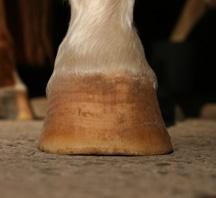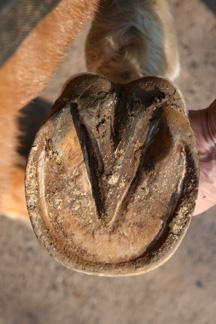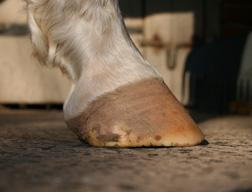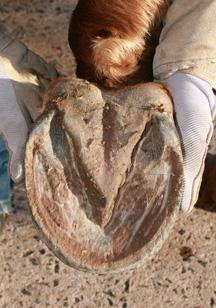- posted: Dec. 21, 2018
Part VI
The previous 5 installments pled for hoofboots to be made legal in dressage competition because some horses cannot be shod with nails or glue, yet need some sort of hoof protection in order to be shown. These articles explained why hoofboots are not only protective for horses’ feet, they are rehabilitative as well. Now, I would like to show you the results, in one horse over a 4 year period, of attempts at shoeing him with nails and steel shoes; with glue and nails in a composite shoe; with glue and a Sigafoos cuff over hoof wall; with glue to the bottom of the foot alone and aluminum shoes; with a heartbar shoe nailed on; and finally an attempt at gluing a composite shoe to the sole, along with a cast around the hoof wall to hold it on. You will see in the upcoming installments how all of these methods resulted in severe destruction of the horse’s hoof during the 4 years. Then you will see how his feet were healed with hoofboots and time, and how they are today. I will show a bunch of photos of his feet during this process.
First however, I would like to show some photos of good, normal horse feet, so that you have a comparison. The feet shown below are of a 6 year old reining bred Quarter horse which never had shoes on the front feet. The horse has been trimmed every 5 weeks since he was a yearling. (Trimming should start with weanlings, but this one was not trimmed early on) The pictures were taken about a month after his last trim.
 This is the right front foot. You can see the toe is worn naturally as it should because of breakover. There is slight flare of the foot at the bottom. This is because the horse was out on PA pasture all summer on the lush grass and got way too fat. He could have foundered, but he didn’t. Luckily, he just got some stretching of the hoof wall away fromP3. Obviously, however, because the stretching occurred, there was some inflammation and tearing of the underlying laminae. He was lucky. But, he has always been a very good footed horse.
This is the right front foot. You can see the toe is worn naturally as it should because of breakover. There is slight flare of the foot at the bottom. This is because the horse was out on PA pasture all summer on the lush grass and got way too fat. He could have foundered, but he didn’t. Luckily, he just got some stretching of the hoof wall away fromP3. Obviously, however, because the stretching occurred, there was some inflammation and tearing of the underlying laminae. He was lucky. But, he has always been a very good footed horse.

Here is the bottom of the right front foot. The frog is big and solid and well formed, and healthy. No infection. The walls are strong. You can see the slight flare on the medial side (to the left). Now that he is on a diet, the walls should grow in tighter to the sole and P3 on the inside.But this foot is very sound. The horse could be shown barefoot.
 This is the right front foot. Notice how the quarters (middle to back of the foot) are properly worn away and relieved above the ground. This is good and is indicative of a strong arch in the internal foot. The toe may be a little long, but he is due for a trim in a week. Horses grow long toes in soft, wet soiled pastures.
This is the right front foot. Notice how the quarters (middle to back of the foot) are properly worn away and relieved above the ground. This is good and is indicative of a strong arch in the internal foot. The toe may be a little long, but he is due for a trim in a week. Horses grow long toes in soft, wet soiled pastures.

Here is the bottom of the right hind foot, just to show you another really healthy, stong foot. The frog is voluminous and large. The walls are strong and tight to the sole. The sole is arched. The sole is never pared on barefoot horses.
Business Hours
8:30 am
6:00 pm
8:30 am
6:00 pm
8:30 am
6:00 pm
8:30 am
7:00 pm*
8:30 am
6:00 pm
8:30 am
12:00 pm
Closed
Closed
